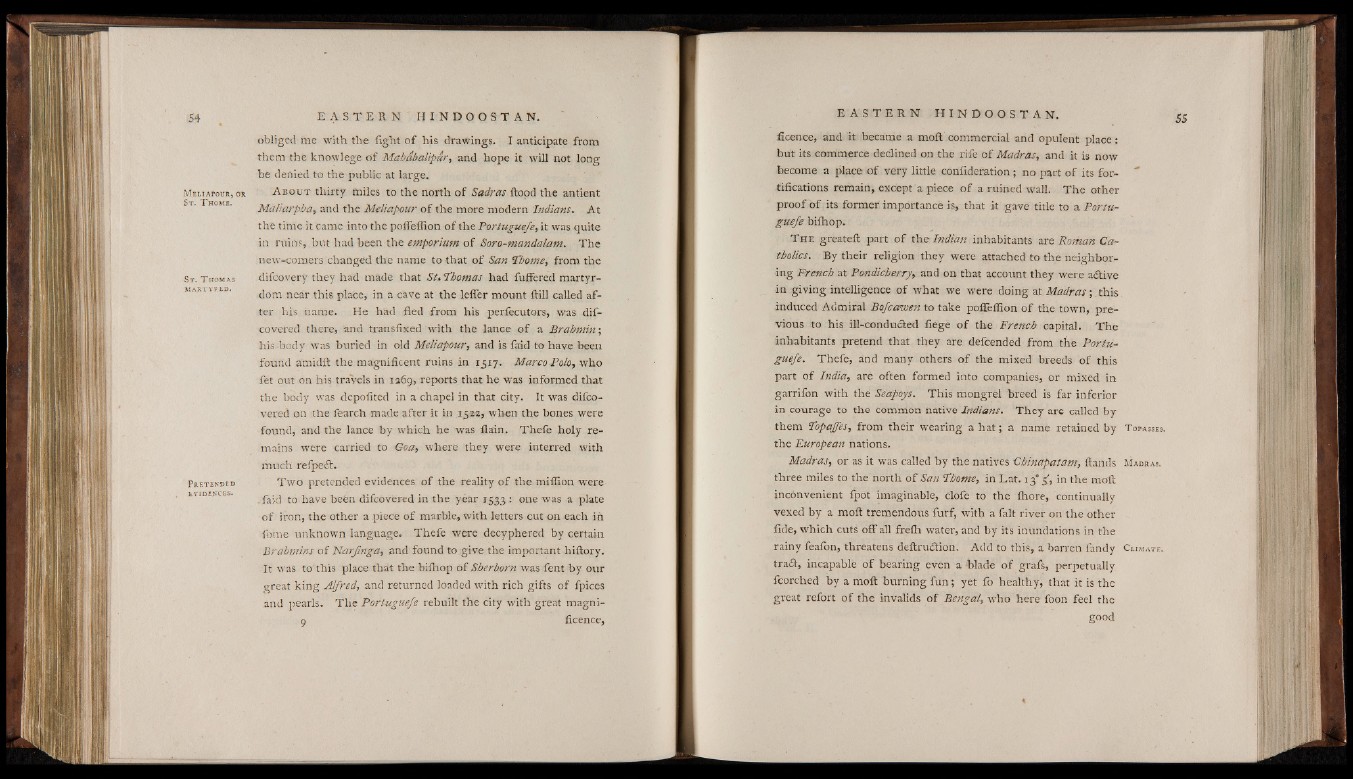
M e l i a p o u r , o r
S t . T h o m e .
S t . T h o m a s
MARTYRED.
P r e t e n d e d
EVIDENCES.
obliged me with the fight of his drawings. I anticipate from
them the knowlege of Mahabalipur, and hope it will not long
be denied to the public at large.
A bout thirty miles to the north of Sadras flood the antient
Matiarpha, and the Meliapour o f the more modern Indians. At
the time it came into the poffeflion o f the Portuguefe, it was quite
in ruins, but had been the emporium o f Soro-mandalam. The
new-comers changed the name to that of San Thome, from the
difcovery they had made that SttThomas had fuffered martyrdom
near this place, in a cave at the leffer mount ftill called after
his name. He had fled from his perlecutors, was dif-
covered there, and transfixed with the lance o f a Brahmin;
his body was buried in old Meliapour, and is faid to have been
found amidft the magnificent ruins in 1517. MarcoPoLo, who
fet out on his trayels in 1469, reports that he was informed that
the body was depofited in a chapel in that city. It was difco-
vered on the fearch made after it in 1542, when the bones were
found, and the lance by which he was flain. Thele holy remains
were carried to Goa, where they were interred with
much refpeft.
Two pretended evidences of the reality of the miflion were
.laid to have been difcovered in the year 1533: one was a plate
of iron, the other a piece of marble, with letters cut on each in
fome unknown language. Thefe were decyphered by certain
Brahmins of Narfinga, and found to give the important hiftory.
It was to' this place that the bilhop of Sherborn was fent by our
great king Alfred, and returned loaded with rich gifts of fpices
and pearls. The Portuguefe rebuilt the city with great magni-
9 licence,
ficence, and it became a molt commercial and opulent place:
but its commerce declined on the rife of Madras, and it is now
became a place of very little confideration; no part of its fortifications
remain, except a piece o f a ruined wall. The other
proof o f its former importance is, that it gave title to a Portuguefe
bilhop.
T he greateft part o f the Indian inhabitants are Roman Catholics.
By their religion they were attached to the neighboring
French at Pondicherry, and on that account they were active
in giving intelligence o f what we were doing at Madras this
induced Admiral Bofcawen to take poffeflion o f the town, previous
to his ill-conducted liege o f the French capital. The
inhabitants pretend that they are defcended from the Portuguefe.
Thefe, and many others o f the mixed breeds of this
part of India, are often formed into companies, or mixed in
garrifon with the Seapoys. This mongrel breed is far inferior
in courage to the common native Indians. They are called by
them TopaJjes, from their wearing a h a t; a name retained by
the European nations.
Madras, or as it was called by the natives Chinapatam, ftands
three miles to the north of San Thome, in Lat. 13” 3', in the moft
inconvenient fpot imaginable, clofe to the ihore, continually
vexed by a moft tremendous furf, with a fait river on the other
fide, which cuts off all frelh water, and by its inundations in the
rainy feafon, threatens deftruction. Add to this, a barren landy
trait, incapable of bearing even a •'blade of grafs, perpetually
fcorched by a moft burning fun; yet fo healthy, that it is the
great refort of the invalids of Bengal, who here foon feel the
good
T o p a s s e s .
M a d r a s .
C l i m a t e .